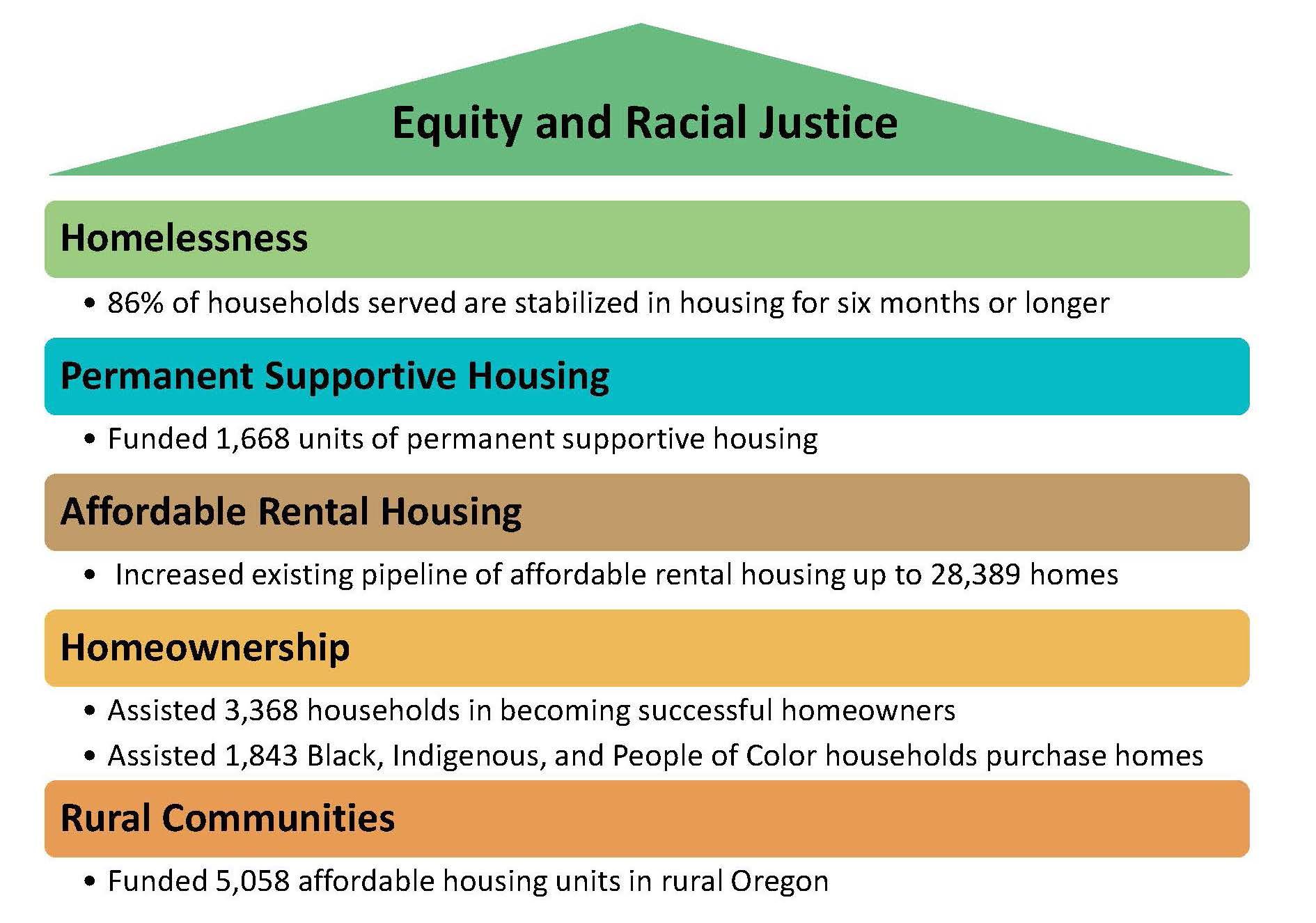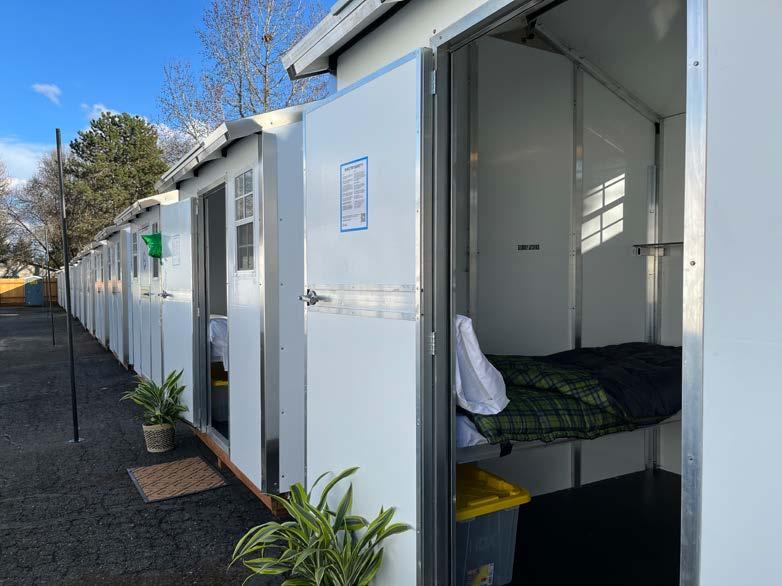Equity and Racial Justice
GOAL A: Communities of color experience increased access to OHCS resources.
GOAL B: Create a shared understanding of racial equity.
Over the past five years, OHCS has undergone significant changes to prioritize equity and racial justice (ERJ). Recognizing that addressing racial disparities required both strategic and personal commitment, OHCS focused on integrating ERJ into the agency’s internal culture and core operations. ERJ milestones include:
• Establishing an Equity, Diversity, and Inclusion office within the agency
• Launching the Racial Equity Analysis Toolkit to help assess policy and program decisions
• Increasing engagement with Tribal Nations and increasing access to funding
• Submitting an agency Diversity, Equity, and Inclusion Action Plan
• Training all OHCS staff on equity and racial justice in housing through Government Alliance on Race and Equity or Center for Equity and Inclusion
PRIORITY Homelessness
GOAL: 85% of households served are stabilized in housing for six months or longer.
FINAL RESULT: 86% of households served are stabilized in housing for six months or longer.
Over the past five years, the homelessness priority has significantly evolved, particularly in response to the COVID-19 pandemic. The plan adapted to the challenges posed by the pandemic, prompting OHCS to launch the Emergency Rental Assistance Program (OERAP) in May 2021. In January 2023, Gov. Tina Kotek declared a state of emergency to address unsheltered homelessness, leading to legislative support for coordinated response efforts, including the passage of HB 5019 and HB 2001. Despite the challenges, OHCS has achieved significant milestones in its homelessness strategies. These include:
• Providing $430 million through OERAP to keep 67,500 individuals who were affected by the pandemic stably housed
• Exceeding Governor Kotek’s goals of increasing shelter bed capacity, rehousing unsheltered households, and preventing households from experiencing homelessness
• Launching a long-term rental assistance pilot program to support young adults transitioning out of foster care, homelessness, corrections, or behavioral health facilities with housing needs
Permanent Supportive Housing
GOAL: Fund the creation of 1,000 permanently supportive homes.
FINAL RESULT: Funded the 1,668 permanent supportive housing units across the state.
Permanent supportive housing (PSH) has emerged as a vital strategy for addressing chronic homelessness, particularly for individuals with complex needs such as mental illness and substance abuse. Initially lacking dedicated funding for capital development, tenancy support, and rental assistance, the agency successfully established the PSH program and begun addressing the significant housing shortage faced by low-income households - especially those identifying as BIPOC, LGBTQ+, or disabled - who often experience chronic homelessness. Significant milestones include:
• Establishing the PSH program to help support PSH development
• Partnering with Corporation for Supportive Housing to establish the annual Oregon Supportive Housing Institute to help development teams
• Opening 16 out of 28 funded developments with PSH units, with 82% of those served either retaining their housing or moving to permanent housing
PRIORITY
Affordable Rental Housing
GOAL: OHCS will triple the existing pipeline of affordable rental housing up to 25,000 homes.
FINAL RESULT: OHCS has built or has in the pipeline 28,389 affordable rental homes.
The affordable rental housing goal was one of the most ambitious SWHP goals with the greatest number of strategies identified. In the past five years, the agency strengthened partnerships by streamlining funding processes, expanding technical support, and adapting funding opportunities to meet urgent needs, while also innovating new programs and funding sources. Key investments, such as Article XI-Q bonds and strong support from Governors Brown and Kotek, were crucial in surpassing this goal. Milestones include:
• Streamlining the funding application process for all available rental housing development resources through the new Oregon Centralized Application process
• Improving user experience with agency data systems
• Increasing funding for partners to build capacity and technical expertise in affordable housing development
• Launched Oregon Housing Needs Analysis with DLCD
• Launched several new funding programs to increase housing production
Homeownership
GOAL A: Assist 6,500 households in becoming successful homeowners.
FINAL RESULT: Assisted 3,368 households become homeowners.
GOAL B: Double the number of homeowners of color in OHCS homeownership programs.
FINAL RESULT: Assisted 1,843 households of color purchase homes.
OHCS has introduced several innovative programs aimed at fostering homeownership, building affordable housing units, and supporting families at risk of losing their homes. The agency had to learn how to pivot within the homeownership priority due to impacts of the COVID-19 pandemic and the 2020 Labor Day Fires. However, it was able to make significant progress, including:
• Launching the new Flex lending program to assist more people with homeownership opportunities
• Adjusting programs like Down Payment Assistance to increase homeownership opportunities for communities of color, culturally specific organizations, and Tribal members
• Launching the Homeowner Assistance Fund distributing over $60 million to assist 2,277
households remain in their homes
PRIORITY
Rural Communities
GOAL: Increase OHCS funded housing development in rural areas by 75%.
FINAL RESULT: Increased OHCS funded housing development in rural areas by 248%, or by 5,058 units
OHCS has worked to expand rental and homeownership opportunities in rural Oregon, significantly increasing the number of rural affordable housing units built or in the pipeline. Recognizing the unique challenges rural areas face in accessing state housing resource, OHCS increased outreach efforts and implemented new strategies such as rural set-asides in funding offerings. Other significant milestones include:
• Facilitating various initiatives, building 138 new affordable homes for homeownership, with favorable loans through the Flex Lending program and Homeownership Assistance Fund
• Strengthening partnerships with Tribal governments, providing additional funding or set-asides
• Dedicating funding for smaller development projects
• Supporting rural nonprofit developers and established a new technical advisor team









